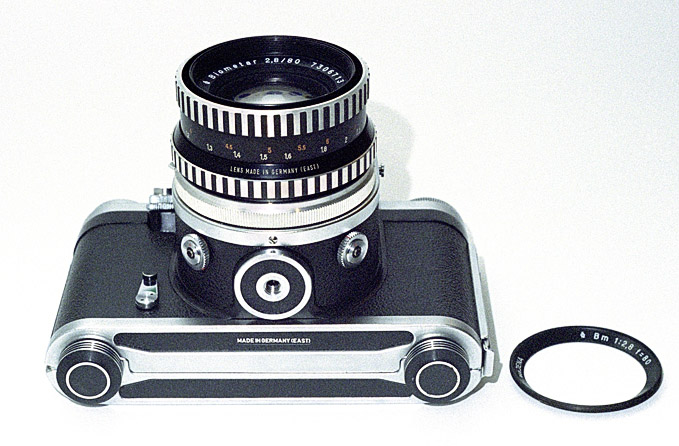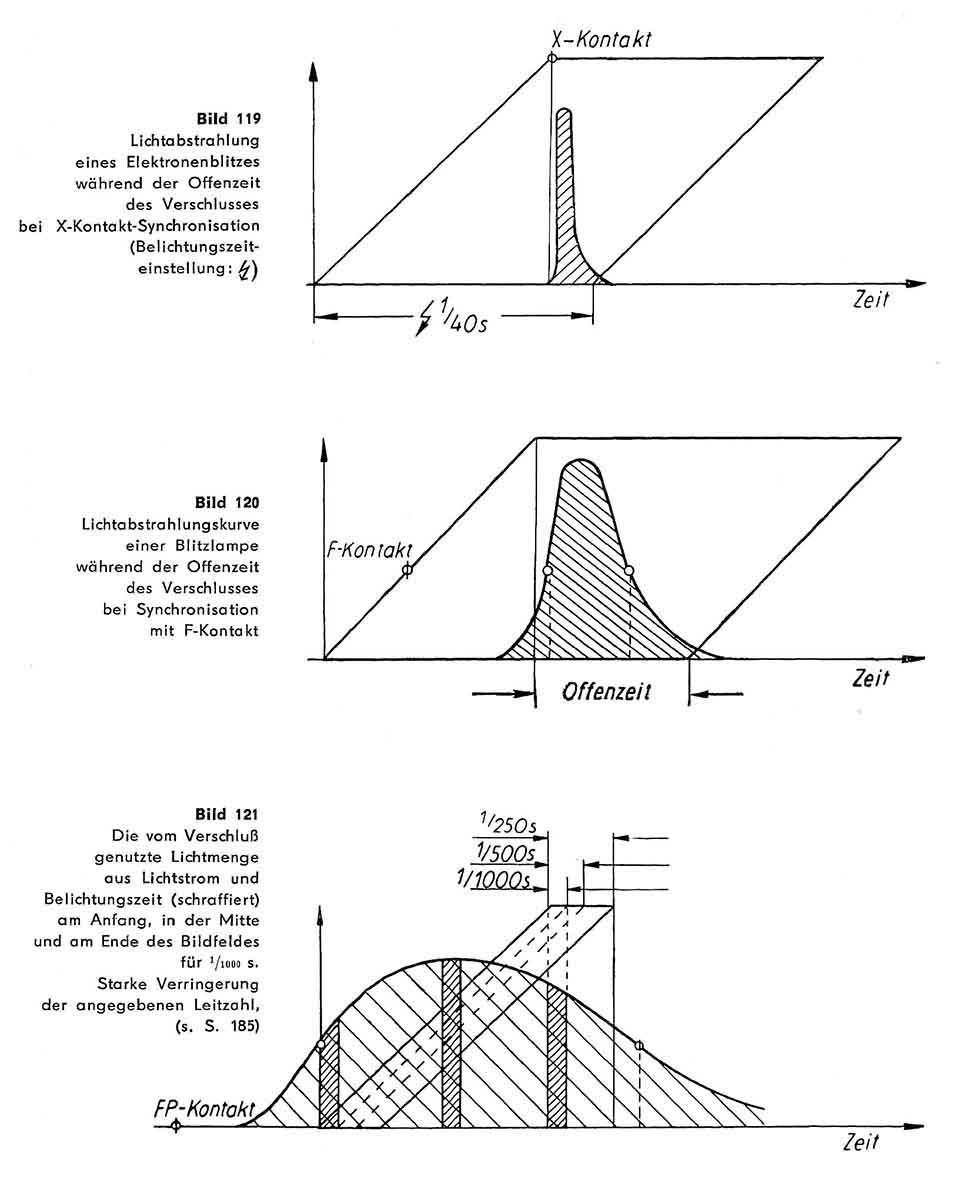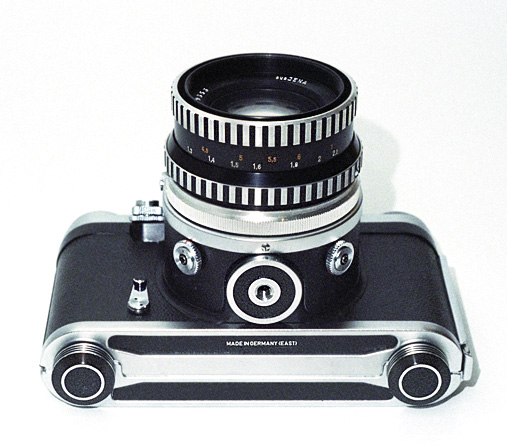by TRA
Flash photography with the Pentacon Six
How to get
Flash Synchronisation
at ALL speeds with Focal Plane Shutters
The previous page (here) explains
how electronic flash works on cameras with Focal Plane
shutters.
Because the duration of light from an electronic flash gun is extremely short (typically a thousandth of a second or less), the time when it is discharged must be synchronised with the time when the camera shutter is fully open.
The same restrictions on
maximum usable flash sync speed apply in the 21st
century (even on digital cameras) as they did 50 or more
years ago:
if the camera has a focal plane shutter, this
consists of two curtains that traverse the frame (or
"film gate") and the higher exposure speeds are achieved
not by moving the curtains faster, but by
progressively exposing the film (from one side of the
frame to the other) through a narrow slit between the
two curtains. The narrower the slit, the shorter
("faster") the exposure.
So the fastest electronic flash sync speed is the
fastest speed at which the whole of the
frame is simultaneously uncovered by the two shutter
curtains.
On 35mm film cameras, this was generally
1/60 sec. (See, for instance, the Minolta SR-T
101.) The SR-T 101, like the earliest 35mm film
cameras (which were not SLRs) had two shutter curtains
that travelled across the frame horizontally,
thus having to cover a distance of 36mm (the width of
the frame in a 35mm film camera).
Some 35mm film cameras achieved a higher sync speed by
having a focal plane shutter that traversed the frame vertically.
If the shutter only has to traverse 24mm (the height of
the frame in a 35mm film camera), even without moving
faster than a horizontally-travelling shutter, it will
complete the job faster, and the highest speed at which
the whole of the frame will be simultaneously uncovered
will be higher. Thus, the Praktica VLC, for
instance, had a flash sync speed of 1/125 sec.
Medium format cameras with a focal plane
shutter have a problem: the frame is bigger, so even if
the shutter moves as fast as it does on a 35mm camera,
it will take longer to traverse the frame. This
means that the fastest speed at which the whole
of the frame will be simultaneously uncovered must be
slower, typically about 1/30 sec.
In this, the Pentacon Six is no better
and no worse than any other medium format camera with a
focal plane shutter.
(Conversely, many digital cameras have a
sensor that is much smaller than the
standard 35mm film frame. Because of this, the
time that the focal plane shutter needs to cross the
sensor is shorter and the shutter speed at which the
whole of the sensor is simultaneously uncovered is
higher, often 1/200 sec.)
But there is a way to get round
this problem!
As stated above, the duration of the
light output from an electronic flash is extremely
short, typically 1/1000 sec or less. But if you
could get a flash gun that would produce a flash that
would last several milliseconds, it could start
transmitting light while a narrow slit of the film was
being exposed (at a high shutter speed) and continue
transmitting light at the same level until that slit had
reached the end of its travel and the whole of the frame
had been exposed. In the Pentacon Six, the time
taken for the two shutter curtains to traverse the frame
is approximately 35 milliseconds.
The effect would be to give
flash sync at all shutter speeds.
And the good news is
that such flashguns do exist!
They are called Focal Plane
Flashguns, or "FP" flashguns for
short.
Note that these flashguns take "FP" flash
bulbs, which are single-use bulbs. And they are still
available in the 21st century. They have a
constant luminescence period of approximately 40 to 50
milliseconds, more than enough to provide even exposure
across the whole of the frame.
BUT
FP bulbs need time to build up to their target output
level. We could call this their ignition
build-up time. This ignition build-up
time (or "start-up time") is laid down in technical
specifications and is 16.5 milliseconds. They then
have a burning time, which is the time
during which they maintain a constant, or virtually
constant, light output. This is long enough for
the two shutter curtains to traverse the full frame
width (or height, depending on the camera), thus giving
the whole of the frame a correct exposure, even
at the top shutter speed, 1/1000 sec in the
case of the Pentacon Six.
However, you can't just mount an FP
flashgun on your Pentacon Six, which (like all other
cameras) is synchronised to fire the flash when the
shutter opens. What you need is a circuit
that will trigger the flash 16.5 milliseconds before
the shutter opens. This is called an "FP" circuit,
whereas a standard electronic flash circuit is called an
"X" circuit.
The Pentacon Six was designed to
incorporate an "FP" circuit and an "X" circuit, and
the chassis on all of them has the space to
accommodate both circuits, each with its own coaxial
sync socket. However, virtually
all Pentacon Sixes left the factory with only the "X"
flash sync circuit installed. This was because by
the mid 1960s most photographers had adopted electronic
flashguns and so had no need for a camera with an "FP"
socket. Except in one country!
The USA.
So you might find a Pentacon Six that was
manufactured for the US market that has both "X" and
"FP" flash circuits. If you do, you will know,
because it will have two flash sockets, under
the camera throat on each side of the lens
(approximately at "5 o'clock" and "7 o'clock").
|
|
|
 Pentacon Six TL prepared for
export to the USA
[C396_14.jpg]
Again, the two flash sockets
can be seen under the camera throat, “X” on the
left and “FP” on the right.
|
| X, F
and FP synchronisation These illustrations from "Praktina Technik" by Erhard Loose and Werner Kühnel try to give a diagrammatic representation of synchronisation with "X", "F" and "FP" flash. "F" are the old-style flashbulbs, and I did not include them in the above description, as they offer no significant advantages over electronic flashguns ("X") and focal plane flash bulbs ("FP"). The diagrams apply to the KW Praktina 35mm camera, which from the mid 1950s to the early 1960s was one of the most advanced SLR cameras on the world market. You can read a little more about it on this website here. "KW", or Kamera-Werkstätten in Dresden, went on to design and manufacture the Praktisix and then the Pentacon Six (although they were subsequently swallowed up into the large State-owned company, Pentacon). In these diagrams, the horizontal axis shows time ("Zeit" in German). The vertical axis shows the amplitude (or brightness) of the flash, indicated in the shaded area. The sloping rectangle or parallelogram is a representation of the movement of the two shutter curtains across the film gate. The first diagram ("Bild 119") is for electronic flash. "X-Kontakt" shows when the flash is fired, which is as soon as the first curtain has cleared the film. The fastest shutter speed for electronic flash synchronisation with the first model of the Praktina was 1/40 sec, as indicated under the diagram with the flash symbol. With the second model of the Praktina, the Praktina FX, the electronic flash synchronisation speed was raised to 1/50 sec (presumably by using a shutter that travelled 25% faster). The second diagram ("Bild 120") is for the old-style "F" flash bulbs. It is possible to see that the flash duration is somewhat longer, but that it is necessary for the camera to trigger the flash ("F-Kontakt") before the first curtain has fully uncovered the film, to allow time for the light output of the bulb to build up. The third diagram ("Bild 121") is for "FP" flash bulbs. Three things are immediately obvious:
The caption for the FP flash diagram points out that the FP flashbulb guide number (the "Leitzahl") is greatly reduced with the high shutter speeds. However, after a few tests it would be possible to determine the correct guide number. Once this is known, a procedure can be standardised, choosing a standard shutter speed and varying the lens aperture dependent on the distance to the subject. For bibliographic information on "Praktina Technik", see here. |
 |
My thanks to CB in Berlin for providing much of the information on which this page is based!
To go on to the next section, click below.
Next section (The Press on sync
speeds)
To go back to the beginning of the flash section, click
below and then choose the section that you want to read
about.
Back to beginning of the flash
section.
To go back to Frequently Asked Questions, click here.
To choose other options, click below.
Home
© TRA January 2014
